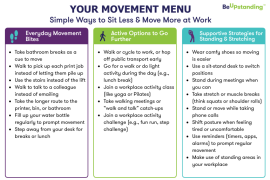Six Strategies for Sitting Less
Scratching your head on how your team can BeUpstanding? A recent study by Hadgraft and colleagues and published in the journal BMC Public Health, explored office workers attitudes around reducing workplace sitting. They also sought out workers opinions on a variety of strategies aimed at reducing occupational sitting, which were commonly identified from previous workplace interventions, and their perceived barriers to achieving this in the workplace. A number of strategies were viewed as acceptable and likely to be adopted by workers with some of the strategies addressing multiple influences on sitting and catering to a range of different jobs and preferences. Why not give some of the strategies a try in your workplace!
- Make use of standing meeting. Sick of sitting through endless meetings? Look to change it up by changing your posture. A standing meeting can be used for a quick check in with the team, while putting stand and stretch breaks into the agenda can help your team reset and refocus. Why not step it up by having a walking meeting for those one-on-one catch ups!

- Communicating face-to-face. Whenever there’s a short message to be conveyed to a co-worker, employees can tell the message in person instead of sending emails. Face-to-face communication can be useful not only to deliver short messages, it can also improve team building within the organisation and encourage collaboration between employees.
- Utilise centralised facilities. Employees can break up prolonged sitting by making use of centralised printer and bins instead of ones that are on their desk. Employees can also take this opportunity to have a 3-minute break and freshen up their mind, especially when dealing with a difficult task. In addition to the benefits for employees, centralising facilities can also be a cost saver for organisations.

- Using apps as prompts. A mobile app can be a good way to remember to get up and move around regularly. Prompts such as these can be particularly useful when it is busy as it is too easy to just forget. Find the app and the scheduling that works for you. Here at BeUpstanding we recommend getting up at least every 30 minutes.
- Learn more about reducing sitting. Educating employees about the importance of reducing sitting can help facilitate the transition to a healthier workplace. Some employees may not be aware of the detrimental health effects of sitting, which includes a higher risk of developing diabetes and cardiovascular disease. The BeUpstanding toolkit gives you all the tools to raise awareness and promote the benefits of sitting less and moving more in your workplace!
- Use an activity tracker. Measuring and tracking sitting and activity is a great way to both raise awareness and monitor changes in these behaviours. There are now mobile apps and wearables that can provide real-time feedback about employees sitting and activity throughout the workday. Using activity trackers can also create a friendly competition among employees, encouraging each other to break up too much sitting. However, it is also important that employees don’t get too caught up with the bells & whistles of these technologies.

These are just some of the ways that your work team can BeUpstanding. We would love to hear what your work team is doing! Tag your strategies in action #beupstanding
This blog post was written by Jun Ian Lim while he was on placement with the BeUpstanding team at the University of Queensland.










Comments are closed.